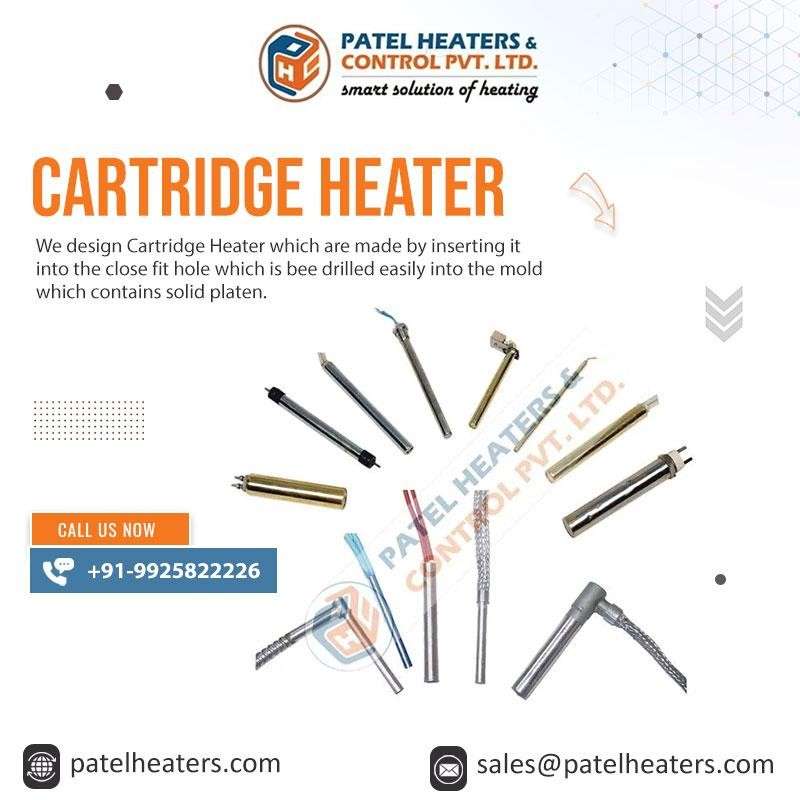Cartridge heaters are compact, cylindrical heating elements that serve a crucial role in various industrial and commercial applications. These heaters are designed to generate and distribute heat efficiently and are commonly used when precise and consistent heating is required. In this blog, we’ll take a deep dive into cartridge heaters, exploring their purpose, operation, and applications.
What Are Cartridge Heaters?
Cartridge heaters, also known as insertion or rod heaters, are cylindrical-shaped heating elements typically made from stainless steel or other corrosion-resistant materials. The key feature of cartridge heaters is their ability to generate concentrated and uniform heat in a confined space.
Cartridge heaters consist of a metal tube or sheath encasing a resistive heating element. Inside this metal sheath is a heating coil made of materials like nickel-chromium (NiCr) or iron-chromium-aluminum (FeCrAl) alloys, which can withstand high temperatures. Several top Cartridge Heater Manufacturers in India use stainless steel or other corrosion-resistant materials to build the sheath of these heaters.
Purpose of Cartridge Heaters:
The primary purpose of cartridge heaters is to generate controlled and uniform heat in various industrial processes. They offer several advantages that make them indispensable in many applications:
Precision Heating: Cartridge heaters are known for their ability to deliver precise and consistent temperatures. This makes them ideal for applications that require accurate heating, such as plastic molding, 3D printing, and medical equipment sterilization.
Rapid Heating: They heat up quickly due to their compact size, making them suitable for processes where fast temperature changes are necessary.
Compact Design: Cartridge heaters are space-efficient and can be easily inserted into holes, bores, or molds, allowing for localized heating in tight spaces.
Energy Efficiency: They are energy-efficient as they directly transfer heat to the target area, minimizing heat loss.
Common Applications:
Cartridge heaters find applications in various industries and processes, including:
Plastic and Rubber Processing: Cartridges are used in extrusion and injection molding machines to maintain the desired temperature for melting and shaping plastics and rubber.
Hot Runner Systems: They are essential components in hot runner systems for plastic injection molding, ensuring the molten material remains at a consistent temperature.
Packaging Machinery: Cartridge heaters are employed in sealing bars and cutting tools of packaging machines for sealing and cutting packaging materials like plastics and foils.
Food Processing: In the food industry, cartridge heaters are used for tasks such as heating platens in food presses and maintaining precise temperatures in cooking and baking equipment.
Laboratory and Medical Equipment: They play a crucial role in laboratory equipment like ovens, incubators, and sterilizers, ensuring accurate and stable temperatures.
Aerospace and Automotive: Cartridge heaters are used in aerospace applications for de-icing systems and in automotive industry processes like engine testing and component molding.
3D Printing: In additive manufacturing, cartridge heaters help maintain consistent temperatures within 3D printers, ensuring reliable printing results.
How Cartridge Heaters Function – The Process Explained!
Cartridge heaters are compact, versatile devices commonly used for heating applications in various industries. These heaters work based on the principles of electrical resistance heating. Discover the technical details of how cartridge heaters operate below;
Heating Element: At the heart of a cartridge heater is its heating element, which is typically made of a high-resistance alloy like nichrome or stainless steel. This alloy has a high electrical resistance, which means it resists the flow of electric current. When electricity passes through the heating element, it encounters resistance, and this resistance generates heat.
Insulation: Surrounding the heating element is an insulating material, usually made of ceramic, that keeps the heat confined to the cartridge heater itself. This insulation prevents heat from escaping into the surrounding environment, ensuring efficient heating.
Outer Sheath: The heating element and insulation are encased in a cylindrical metal sheath, often made of stainless steel. This sheath provides structural support and protection for the internal components. It also helps to distribute the heat evenly along the length of the cartridge.
Power Supply: To operate a cartridge heater, it needs to be connected to an electrical power source. The amount of heat produced depends on the voltage and current supplied to the heater. A higher voltage or current results in more heat generated.
Temperature Control: Temperature control in cartridge heaters can be achieved through various methods:
On/Off Control: The simplest way to control the temperature is by turning the heater on and off using a switch or a relay. This method is suitable for applications where precise temperature control is not critical.
Thermostats: Cartridge heaters can be equipped with thermostats, which are temperature-sensitive switches. These thermostats open or close the electrical circuit based on the temperature, maintaining a set temperature range.
PID Controllers: For more precise temperature control, Proportional-Integral-Derivative (PID) controllers can be used. These controllers monitor the temperature and adjust the power supplied to the heater continuously to maintain a specific setpoint temperature. PID controllers are commonly used in applications where tight temperature control is essential, such as in industrial processes.
Conclusion
Cartridge heaters may be small in size, but they have a big impact on various industrial and commercial applications. Understanding their purpose, operation, and applications is key to appreciating their significance in modern industries.
Patel Heaters & Control Pvt. Ltd. is a leading name in the field of cartridge heaters in India. They design and manufacture top-notch cartridge heaters in their state-of-the-art manufacturing unit. Each heater is built with high attention to detail using the best quality raw materials.
What sets them apart is their rigorous testing process, ensuring that every cartridge heater they produce meets the highest industry standards. As one of the best cartridge heater suppliers in India, they stand as a symbol of excellence in the heating technology industry.

As the editor of the blog, She curate insightful content that sparks curiosity and fosters learning. With a passion for storytelling and a keen eye for detail, she strive to bring diverse perspectives and engaging narratives to readers, ensuring every piece informs, inspires, and enriches.










